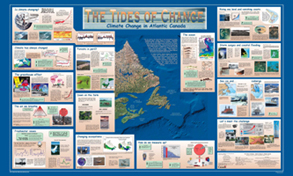Proactive disclosure
Print version   |  | 
Natural Resources Canada > Earth Sciences Sector > Priorities > Climate Change Impacts and Adaptation > Curriculum Tools
Climate Change in Canada - Curriculum Tools
Grade 5 - Teacher's Resource The Tides of Change: Climate Change in Atlantic Canada
Please note: These exercises are not designed to be filled out nor printed from your Web browser. Please download and print the PDF files located at the bottom of the page.
The Causes of Climate Change
Did You Know?
- Although Canada has only 0.5% of the world's population, it produces 2% of this.
Global CO2 emissions
The Greenhouse Effect
- What are "the big three" greenhouse gases?
Carbon dioxide, methane, nitrous oxide
- Why does CO2 have the greatest influence?
Most abundant
The Air We Breathe
- What are three types of fossil fuels?
Gasoline, oil, coal
- What are fossil fuels used for?
Energy
- What does burning fossil fuels do?
Emits greenhouse gases
- What activity is responsible for 26% of greenhouse gas emissions in Canada?
Transportation
How Do We Measure Up?
- Looking at the Annual Greenhouse Gas Emissions per capita data, how many tonnes of CO2 was each Canadian emitting?
21.4 tonnes/year
- In Atlantic Canada, what are the four areas contributing most to greenhouse gas emissions?
Transportation, Residential and commercial buildings, Industrial activity, Electricity generation
| Connections |
Reflections |
Questions |
| What connections can you make among what you've learned, your lifestyle, your family, school, community, or other regions? |
Reflect on your learning, understandings, and discoveries."Write about one thing you did not know before starting this activity" |
What questions do you still have, or what new questions have been raised? |
The Consequences of Climate Change
Did You Know?
- What are all species in the marine food web affected by?
Changes in water temperature
Is Climate Changing?
- What is happening to most of the world's glaciers?
Shrinking
- Find the Temperature Change maps. What areas of the map show the greatest temperature change?
The poles – high latitudes and interior of continents
Freshwater Issues
- How could hydro-electricity be affected by climate change?
Increased water flow = more power; reduced water flow with increased evaporation = less power
Forests in Peril?
- Why might the Gypsy moth threaten Canadian forests if warming continues?
Large numbers are a threat to trees, and since the moths die at temperatures below -9║C, warming may not allow enough deaths.
Storm Surges and Coastal Flooding
- Why may storm surges cause more frequent and severe flooding?
Sea level rising – begin to flood areas never before flooded
Down on the Farm:
- What is the greatest concern for agriculture in Atlantic Canada?
Trend toward more extreme weather events
- How would more storms, hail, floods and droughts affect farms?
Damage crops, livestock, hydropower generation, power lines
- Make a list of positive and negative consequences for farmers if global warming continues.
| Positive |
Negative |
| longer growing season; higher yields less loss from winter kill fall harvesting easier vineyards |
drought; increased irrigation $ increased winter insect pests more generations of summer pests more common pests |
Rising Sea Level and Vanishing Coasts:
- What specific types of coastal areas will be most affected by sea-level rise?
Salt marshes, lagoons, etc.
Sea Ice and Icebergs:
- What will happen to sea ice with global climate change?
It will become thinner, and less extensive
- What benefits and concerns would there be with less sea ice?
Shipping season lengthened, ice breakers not necessary, less risk of icebergs hitting oil platform (decrease costs)
Increased coastal erosion, more storm damage to man-made structures
Changing Ecosystems
- How will climate change affect vegetation zones?
Distribution of vegetation zones will change
- How will wildlife populations handle a changing ecosystem or habitat?
Some will move north, others will stay, some populations will become extinct
| Connections |
Reflections |
Questions |
| What connections can you make among what you've learned, your lifestyle, your family, school, community, or other regions? |
Reflect on your learning, understandings, and discoveries."Write about one thing you did not know before starting this activity" |
What questions do you still have, or what new questions have been raised? |
Action on Climate Change
Did You Know?
- What percent does Canada aim to reduce its emissions by under the Kyoto Protocol?
6%
- What is the fastest, cheapest and surest way to reduce greenhouse gas emissions?
Improving energy efficiency
Let's Meet the Challenge:
- When we save energy or replace fossil fuels, what do we help to do?<
Reduce greenhouse gas emission
- What are some low-emission ways to travel?
Bicycling, walking, rollerblading, riding buses and trains, carpooling
- What are five other types of energy that would reduce greenhouse gas emissions?
Solar energy, pedal power, earth energy, community energy, wind energy
| What I am already doing... |
What I can begin to do... |
|
|
Downloads:
|

